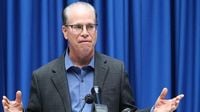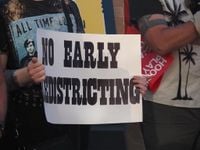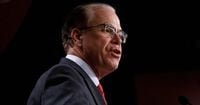Indiana is about to become the newest battleground in the intensifying national fight over congressional redistricting, as Governor Mike Braun on Monday called for a special legislative session to redraw the state’s U.S. House maps. The move, announced on October 27, 2025, comes after weeks of mounting pressure from President Donald Trump, Vice President JD Vance, and other top Republican officials, all eager to shore up GOP control ahead of the 2026 midterm elections.
Governor Braun’s order sets the special session for November 3, 2025, with a primary focus on revising Indiana’s congressional boundaries—lines last drawn in 2021 following the decennial U.S. Census. But the session will also address an urgent tax issue: aligning Indiana’s tax code with new federal provisions from the One Big Beautiful Bill Act, which impact the state’s 2026 tax filings. According to the governor’s office, addressing this discrepancy is crucial for providing “taxpayers, accountants and businesses the confidence and clarity ahead of filing season, avoid amended returns and filing delays, and continue the Indiana Department of Revenue’s strong record of fiscal management.”
“I am calling a special legislative session to protect Hoosiers from efforts in other states that seek to diminish their voice in Washington and ensure their representation in Congress is fair,” Braun said in a statement Monday, as reported by the Associated Press and the Indiana Capital Chronicle. He also stressed the importance of tax code conformity to ensure “stability and certainty for taxpayers and tax preparers for 2026 filings.”
This is no ordinary political maneuver. The stakes are high, and the timing is tight. Candidate filing for Indiana’s 2026 primary opens January 7, leaving lawmakers with just weeks to debate, approve new maps, and navigate the inevitable legal challenges. The special session, by law, can last no more than 30 session days or 40 calendar days—a ticking clock that adds urgency to an already fraught process.
The push for redistricting is part of a broader national effort by Republicans to redraw congressional maps in states where they hold legislative power. Trump, who won Indiana by 19 percentage points in 2024, has been especially vocal in urging the GOP to redraw boundaries in their favor. According to the Associated Press, Trump and Vice President Vance have each met separately with Indiana Republicans, including Senate President Pro Tem Rodric Bray, in recent months. Trump even spoke directly with Indiana Senate Republicans by phone on October 17, pressing the case for new maps that might help the party maintain its narrow U.S. House majority.
But the effort is not without resistance—both from Democrats and within the GOP’s own ranks. Indiana Republicans currently enjoy a supermajority in both chambers of the state legislature, and they outnumber Democrats 7-2 in the state’s congressional delegation. Yet, as of October 27, at least a dozen of the 40 Republican senators remain opposed to midcycle redistricting, and a spokesperson for Senate Republicans confirmed that “the votes still aren’t there for redistricting.”
House Republicans, on the other hand, appear more unified. A House GOP spokesperson told the Indiana Capital Chronicle that their caucus has enough votes to proceed. House Speaker Todd Huston said in a brief statement, “We have received the Governor’s call for a special session and will continue having conversations within our caucus and with our counterparts in the Senate on our next steps.”
Governor Braun, for his part, remains optimistic. In a Monday afternoon interview on WIBC, he said, “When you hear ‘The votes aren’t there,’ that’s mostly coming from Democrats and others that don’t want it to occur. Once this goes public, you’ll have people getting off the fence, and you’re going to see the votes will be there.” He added, “We think we’re close enough to where, once it becomes a public discussion … any senators that are still waffling will hear from their own constituents.”
The proposed redistricting effort is laser-focused on flipping Indiana’s 1st Congressional District, a long-time Democratic stronghold in the northwest corner of the state, including Gary and other cities near Chicago. Republican leaders also have their eyes on the 7th District, which includes Indianapolis, though dividing the state’s largest city to dilute Black voters’ influence would be far more controversial.
Democrats, meanwhile, are crying foul. Senate Democratic Leader Shelli Yoder called the special session “a political stunt at the expense of every working Hoosier,” accusing Republicans of bowing to national pressure. “This is not democracy. This is desperation,” Yoder said in a statement. “There is no new census, no court order and no support from the public. There is only political greed and fear—fear of voters, fear of accountability, fear of losing power the right way, at the ballot box.”
U.S. Rep. Frank Mrvan, the Democrat who represents the 1st District, was equally caustic. “The only thing more unpopular in Indiana than redistricting is the governor himself,” Mrvan said. “His attempt to silence the very voters he represents is yet another example of how out of touch he is with the people of our great state.”
Public opinion appears to back the critics. According to recent polls cited by the Indiana Capital Chronicle, a majority of Hoosiers—about 53%—oppose early redistricting, compared to just 34% who support it. Another survey found growing distrust in both parties, with more voters feeling disconnected from state political leadership.
Still, the Republican Party’s state leadership is pressing ahead. Indiana Republican Party Chairwoman Lana Keesling praised Braun’s move, arguing that “if Indiana is to have fair representation in Congress, redistricting is an absolute necessity.” She charged that Democrat-controlled states have “spent years maintaining deeply partisan election maps” and insisted that Indiana should not “allow sanctuary-state politics to dictate our voice in Washington.”
Nationally, Indiana is not alone. Similar redistricting battles are playing out in Virginia, Texas, Missouri, North Carolina, Illinois, and Kansas. In Virginia, Democrats are racing to pass a constitutional amendment that could eventually allow them to redraw that state’s maps. In Illinois, U.S. House Minority Leader Hakeem Jeffries met with Democratic lawmakers to discuss redrawing districts to further favor Democrats. Meanwhile, in Kansas, Republicans are inching closer to calling themselves into a special session on redistricting, despite opposition from the Democratic governor.
In Indiana, the outcome remains uncertain. Legislative leaders are expected to outline their next steps in the coming days, and the special session could last anywhere from a few days to the maximum 40 calendar days allowed by law. The last time Indiana redrew its congressional lines, the process stretched over several months and included statewide public hearings. This time, lawmakers will be under even greater pressure to move quickly, with the eyes of the nation—and both political parties—watching closely.
Whatever the result, one thing is clear: Indiana’s redistricting fight is more than just a local squabble. It’s a flashpoint in a larger, nationwide struggle over political power, representation, and the future of American democracy.


